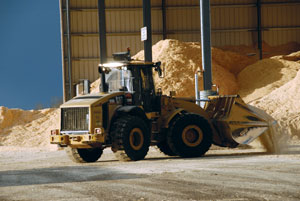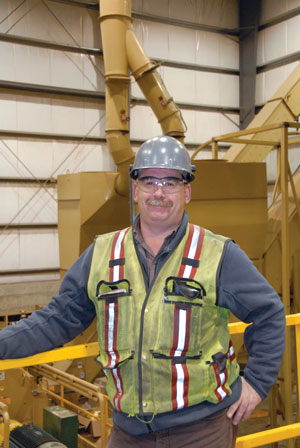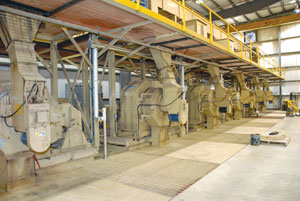
Banking on Pellets
December 4, 2009
By Bill Tice
The latest pellet plant to grace British Columbia’s Cariboo country has been up and running now for just over a year. In that time, the plant staff has forged an economic and environmental success story in what has been an extremely tough period for a region that relies heavily on the forest industry for its economic strength.
 |
|
| Two Caterpillar 950 wheel loaders are used to move fibre around the storage yard and to load the plant’s infeed bins. Shavings that are already dry when they arrive are put under covered storage.
|
The latest pellet plant to grace British Columbia’s Cariboo country has been up and running now for just over a year. In that time, the plant staff has forged an economic and environmental success story in what has been an extremely tough period for a region that relies heavily on the forest industry for its economic strength.
The plant, called Meadowbank, is the latest addition to British Columbia-based Pinnacle Pellet, a home-grown company that has blossomed from producing just 60,000 tonnes/year of wood pellets from one plant in 2004 to a group of five plants that today churns out a combined volume of close to 750,000 tonnes of wood pellets annually.
“Just at this plant alone, we are capable of producing over 200,000 tonnes of wood pellets on an annual basis,” says Jack Levesque, plant manager at the new facility, which is strategically located about 70 km south of Prince George and adjacent to the major north–south thoroughfare for the province, Highway 97.
 |
|
| Plant manager Jack Levesque has been at the Meadowbank plant for just over a year. |
Levesque is like a proud parent as he shows off the plant. “This is a very efficient facility,” he explains. “It was designed on a small footprint, which minimizes material handling and streamlines the process. We can operate 24 hours/day, seven days a week, with a total of just 24 people.”
A Ravenous Diet
In addition to the efficiency of the new plant, Levesque says the facility’s ravenous diet of sawmill residuals has had the environmental benefit of extinguishing several sawmill burners in the region. In the past, these burners were the main method of disposing of unwanted sawmill waste. “We’ve shut four burners down since we started up,” he explains. “That includes the Dunkley Lumber mill just next door to us, Canfor’s Clear Lake Sawmills near Prince George, and both the Conifex and Northern Interior Forest Products burners in Fort St. James.”
Most of the sawmill residuals from nearby mills are trucked to the Meadowbank plant by Arrow Transport in trailers with walking floor systems. Residuals from further afield, such as the fibre making the four-hour trip from the mills in Fort St. James, are shipped in larger B-trains. The plant also uses what Levesque calls “mill grind”, which is essentially solid waste products from sawmills, including trim blocks, bark, and log ends. This material is trucked to the pellet plant, and then an on-site Peterson 4710 portable grinder owned by Pinnacle and a Morbark drum grinder operated by a contractor process the material to usable fibre for the plant. “This is essentially any solid wood waste that sawmills can’t use, but we can,” Levesque explains.
Another growing source of fibre for Meadow-bank is bush waste, which includes stumps and limbs left over from logging activities. Currently, this represents up to 30% of the fibre required for the plant, but Levesque says they expect that number to grow in the future. He adds that the bush waste is ground at the logging block to a four-inch size and then further refined at the plant with a large stationary hogger manufactured by West Salem Machinery.

|
|
| The plant’s production process features six Andritz Sprout pelletizers that process the wood fibre into quarter-inch pellets. |
Production Flow
The mill’s dependence on fibre is evident from the huge piles of sawdust, mill waste, and logging debris that surround the infeed to the plant, and the continuous flow of trucks that back up to the facility’s hydraulic tipper where their trailers are emptied. A pair of Cat 950 wheel loaders moves most of the fibre from the storage piles to one of the mill’s three infeed bins, one of which is reserved for shavings that have been placed in covered storage on arrival at the plant, as they are already dry and can bypass Meadowbank’s drying process.
From the infeed bins, all material goes to one of two Bliss hammermills, where the fibre is further refined to a more consistent product that is better suited to pellet production. Next are the mill’s massive dryers, a pair of M-E-C S1360 single-pass drum models that measure 60 feet long and 13 feet in diameter.
The next step is for the material from the dryers to be fed into a surge bin and then to one of six Andritz Sprout pelletizers, where natural resin from the wood binds the product together, and metal dies form the quarter-inch round pellets. From the pelletizers, the pellets drop to a cooling bin and then a vibrating conveyor system that features Optimil screens, where any fines drop out. The fines and any leftover dust are collected and used to power the mill’s dryers. The finished pellets go to either a 3,000-tonne storage silo or a 100-tonne rail load-out silo, both manufactured by Westeel. The load-out silo sits above a CN Rail spur that can accommodate up to 27 rail cars. The rail cars are loaded using a method similar to grain handling.
Smaller but necessary equipment used in the Meadowbank plant includes Grecon spark detectors that are positioned at various points in the process, rare earth magnets for detecting any metal that may have been inadvertently introduced to the system, two MoistTech in-line moisture sensors to check the moisture content of the product coming out of the dryers, and a Baldor 500-kW generator. Levesque says the generator is an important safety feature, as in the event of a power outage, it will automatically kick in, powering the dryers and the fans that keep the product moving through the system. “If everything just stopped it could create a fire hazard in the dryers, so this is a critical piece of equipment for us,” he explains.
All pellets from Meadowbank are transported by rail to the Port of Vancouver, where they are loaded onto ships for major markets in Europe, including the Netherlands, Belgium, and the United Kingdom.
Planning and Construction
Pinnacle Pellet’s president Craig Lodge says that the design, planning, and construction of the Meadowbank plant took just over 10 months and was a team effort. He notes that the actual construction was done in about 100 days, but planning, permit approvals, and securing suitable fibre contracts took the extra time. While building the plant, Lodge says they turned to other Pinnacle plant managers and internal specialists for input, and worked closely with major contractors that included Del-Tech’s BID Construction Group in Prince George, Service Electric in Quesnel, and Allied Blower in Williams Lake.
As for the timing and location of the Meadowbank plant, Lodge says they have three basic requirements when looking for a location for a pellet plant. “We need access to raw material, we need access to a power supply, and we need access to a rail line. In this case, we had all three.”
Lodge also notes that the best scenario is to be close to a host sawmill for the raw materials, and Dunkley Lumber, which is just 4 km away, fit the bill. “We have a company objective to grow the business when suitable opportunities arise, and Dunkley had an uncommitted supply of sawmill residuals,” he explains. “It was a good fit.”
He also says the process has been getting easier with each facility they build. “When we built the Meadowbank plant, we enjoyed the fact that it wasn’t the first time through this process for us,” he says, referring to their past track record, which includes building three successful greenfield pellet plants – the two south of Meadowbank at Quesnel and Williams Lake, and another plant to the northwest in Houston, B.C., that is jointly owned by Pinnacle, Canadian Forest Products (Canfor), and the Moricetown First Nation. The company’s only other pellet plant was an existing plant they acquired in Armstrong, B.C. “Every time we build a plant, we gain experience and we take the best of what we have learned and incorporate it into our next project,” Lodge adds.
As for plant manager Levesque, he came on board in August 2008, when most of the construction was complete. He says that although he missed the permitting, approval, and construction stages, he was here to experience the plant’s start-up curve first hand. “We had our challenges, but we had a great group of people and we got through it,” he says. “It was a tough winter in terms of weather – very harsh, long, and cold – so it took some work to get the dryers where we wanted them. And with all of the sawmill shutdowns and curtailments last year, we had to make sure we had a sufficient source of fibre.”
Looking Ahead
Looking down the road, both Levesque and Lodge say they foresee steady growth in biomass and the wood pellet industry over the next decade. “We believe the utilization of biomass will continue to grow,” says Lodge, who grew up in a logging family in Fort St. James, B.C., and is a forester by profession. “Biomass is environmentally friendly, it is derived from a source that is ultimately renewable, and pellets will continue to play a key role in the industry as they provide an efficient way of providing fuel for biomass power.”
It’s an opinion shared by many, especially in Europe, Japan, and Ontario, where Lodge says wood pellets are increasingly viewed as a substitution fuel for coal or other fossil fuels. With an investment in Meadowbank of nearly $25 million, it’s also an opinion Pinnacle is banking on. •
Bill Tice is Canadian Biomass’ western editor based in Vancouver. In addition to working in the forest industry for such companies as Canfor and West Fraser, Bill has been covering the forest sector for more than 20 years.
Print this page